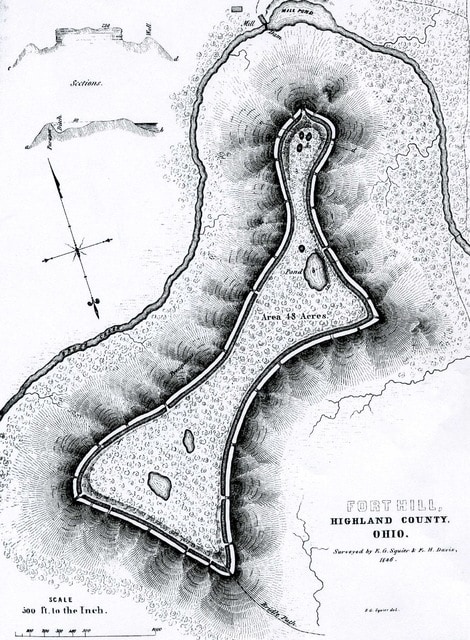
Editor’s note: For many years, local historian Jean Wallis provided a feature to The Times-Gazette called “Highland Guidepost.” She is updating and resubmitting some of those articles from time to time, including this one.
The book “Ancient Monuments of the Mississippi Valley” by Ephraim George Squier and Edwin Hamilton Davis, was a remarkable event in the study of American archaeology. Henry C. Shetrone wrote in 1930, “Ancient Monuments is now a rare and highly sought literary and scientific treasure, the pride of any student of American archaeology who is so fortunate as to possess a copy of the book.”
Ephrain George Squier was a self-educated individual in civil engineering, journalism and literature. He was born in 1821 and at the age of 24 left Hartford, Connecticut, where he had been editor of the Evening Journal, a Whig publication supporting Henry Clay for the presidency to become editor of the Scioto Gazette in Chillicothe, Ohio. There he met a young doctor, Edwin Hamilton Davis.
Edwin Hamilton Davis was born Jan. 22, 1811 in Hillsborough, the son of Henry and Alice Davis. Henry opened a primitive nail factory on North High Street across from the courthouse. History tells us that his rolled iron was prepared in Pittsburgh for the various sizes of nails, which after being cut by heavy shears, one by one, were headed in a clamp by a blow with a heavy sledge hammer.
By this slow process, Henry Davis was able to educate his four sons, Joseph S., Werter R., William Henry and Edwin Hamilton, at Kenyon College. The latter was educated at Kenyon and received his medical degree in Cincinnati in 1838 when he was 26 years old.
Davis, having grown up in southern Ohio, was aware of the abundance of prehistoric Indian mounds in the area. While a student at Kenyon he explored some of the mounds and delivered an address, “Antiquities of Ohio,” at the college commencement in 1833. In 1836 he assisted Charles Whittlesey, topographic engineer of Ohio, in his very valuable surveys of Indian mounds and earthworks in the state.
Edwin Davis practiced medicine in Chillicothe from 1838 to 1859. “This provided the necessary funds for the explorations, excavations and surveys for some 200 mounds and earthworks in southcentral Ohio,” according to the “Ancient Monuments” book.
“While Davis had a deep interest in Ohio prehistory for some 15 years, by the time the two men met in Chillicothe in 1845, it was the writing skill of Squier and his ability to promote his activities which transformed their archaeological activities from an avocation to a scientific accomplishment that won national and international acclaim.”
On Nov. 9, 1841 Edwin Hamilton Davis married Lucy Woodbridge in Chillicothe. Lucy was born in Chillicothe on May 9, 1818, the daughter of John Woodbridge and his wife Elizabeth Buchanan. Woodbridge was a banker in Chillicothe and part owner of the Rapid Forge foundry in Paint and Paxton Townships from 1816 to 1852. At the time of his death he owned over 2,000 acres of land in the area of the “Point” including the Seven Caves.
Later on Dr. Davis removed with his family to New York and the New York Medical College. He, Lucy and some of their children are buried in the Grandview Cemetery in Chillicothe overlooking the Scioto Valley. Ephraim George Squier died April 17, 1888 in Brooklyn, N.Y.


